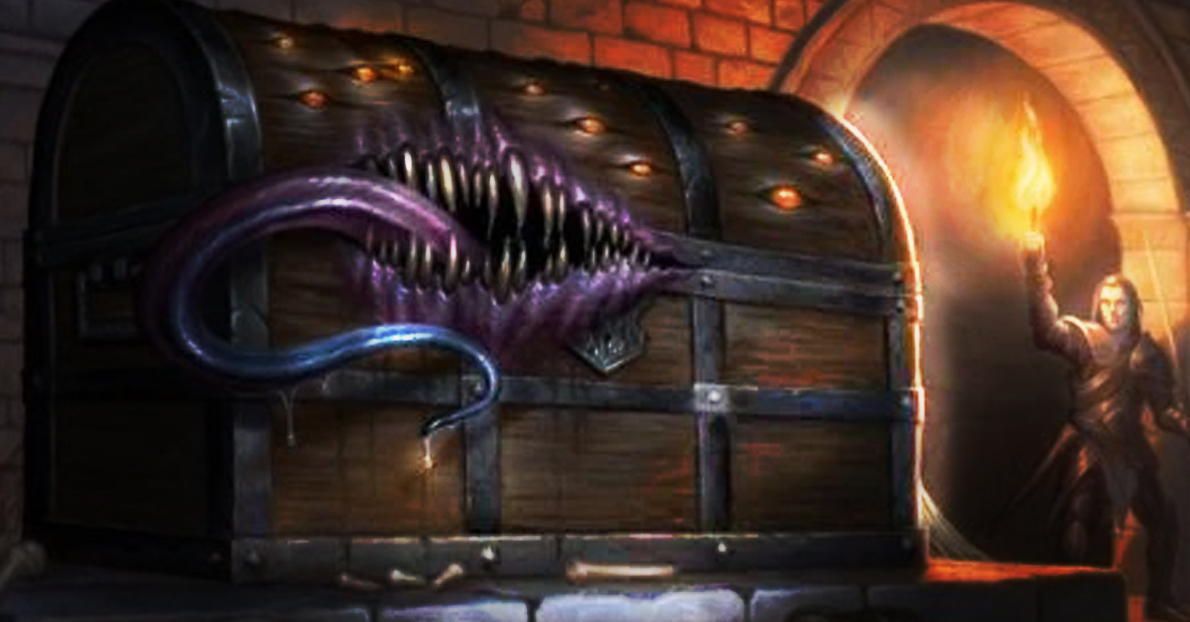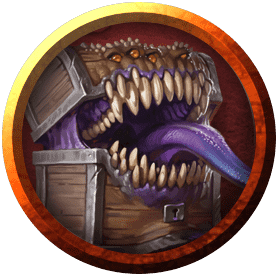Mimic (/ˈmimik/)
A Deadly Deception
Imitative Predators.
Mimics can alter their outward texture to resemble wood, stone, and other basic materials, and they have evolved to assume the appearance of objects that other creatures are likely to come into contact with. A mimic in its altered form is nearly unrecognizable until potential prey blunders into its reach, whereupon the monster sprouts pseudopods and attacks. When it changes shape, a mimic excretes an adhesive that helps it seize prey and weapons that touch it. The adhesive is absorbed when the mimic assumes its amorphous form and on parts the mimic uses to move itself.Cunning Hunters.
Mimics live and hunt alone, though they occasionally share their feeding grounds with other creatures. Although most mimics have only predatory intelligence, a rare few evolve greater cunning and the ability to carry on simple conversations in Common or Undercommon. Such mimics might allow safe passage through their domains or provide useful information in exchange for food.The Mighty Menagerie fought one in Jacoby Drexelhand's room under the River's Keep
Basic Information
Anatomy
Description
Mimics occupied a volume of approximately 15 cubic feet (0.42 cubic meters). They could assume any shape, provided that they retained the same volume. In order to most effectively lure adventurers, they most commonly took the shape of doors, chests, and other objects likely to be touched. Their skin texture and color could change to almost perfectly resemble wood, stone, metal, and other basic materials. Though the natural state of a mimic's skin was a rough speckled grey similar to granite.Ecology and Habitats
Ecology
Although mimics were usually solitary hunters, they often shared their vast territories with other species. A meal of one or two humanoids could sustain a mimic for several weeks. They reproduced by splitting, growing to adulthood within a few years. There were several subspecies of mimics, roughly divided into two groups: a larger, more aggressive, and less intelligent variant, known as killer mimics; and a smaller, more cunning variant known as common mimic that was capable of language and more refined combat tactics. Mimics of the second variety could disguise themselves as more ornate furnishings and were capable of negotiating and bargaining. They spoke their own language, as well as the languages of nearby communities. Intelligent mimics were known to sometimes offer information or safe passage through their territory in exchange for food.[1] More rare were the book mimics, bred in secret by the Church of Oghma since the mid-twelfth century Dale Reckoning. Book mimics were bred to envelop a book and protect it from moisture, flame, or physical damage, taking a small amount of blood from readers if no other food was to be had. Most book mimics were as smart as an unschooled human, but they could be less or more intelligent than that. Rarely, mimics would establish large colonies, within which they could communicate telepathically with each other and with outsider mimics. Juvenile mimics born in a colony retained their telepathic abilities even away from their homes.Behaviour
Combat
“ Look, when I tell you not to touch anything, I have a very good reason. Let’s just say that sometimes the dungeon bites back. ”Mimics hunted by standing perfectly still until a creature came into contact with them. They then attacked their victims by using a powerful adhesive secretion to trap them, while also employing their strong pseudopods to attack and further restrain the creatures' movements. The adhesive, which was also a mimic's main means of locomotion, could be weakened by the application of alcohol over a few seconds, and was completely neutralized less than a minute after the mimic's death.
Additional Information
Uses, Products & Exploitation
Uses
The skin of mimics could be used as an ingredient for making polymorph self potions. Their adhesive secretions could also be sold to alchemists and their internal organs could be used in the production of perfumes or as food. Some cultures considered mimic organs tasty delicacies.Harvesting
Instructions| DC | Item | Description | Value | Weight | Expiration | Crafting |
|---|---|---|---|---|---|---|
| 5 | Mimic Adhesive (vial) | A mimic can secrete a strong, clear adhesive. This glue-like substance dries very fast, and must be harvested quickly. The adhesive is valued by all kinds of craftsmen. | 4 gp | 2 lb. | 14 days | - |
| 15 | Mimic Skin Strip | When a mimic dies, it slowly melts into its original form, an amorphous gray blob. It is difficult to harvest even a strip of flesh from the creature, as it is like cutting through water. A mimic's natural skin is not good for making leather, but it is valued by transmutation spellcasters and those that study polymorphing. | 5 gp | 3 lb. | 10 days | - |
This kind of creature does not normally carry treasure. This kind of creature does not normally have or collect treasure. However, the creature may have a lair full of bodies, or reside somewhere that treasure already exists.
This creature produces 2-12 pieces of Harvested Meat, weight of 4 lb each. DC: 5, Expire: 1 day, Value: 2 sp each. The meat of many monsters is considered vile and distasteful. Monstrosities and aberrations, in particular, may have tainted blood or rancid tasting meat. Dungeon Master's discretion.
Geographic Origin and Distribution
Perception and Sensory Capabilities
Abilities
Mimics were capable of altering the pigmentation and texture of their skins by pumping a brown pigmented fluid from internal muscular organs through surface capillary vessels. While the pigment granted them the appearance of wood, the capillaries themselves granted an appearance of wood grain. This fluid could be more readily seen in wounded mimics. Their skins were covered with light-sensitive sensors that could detect heat out to a range of 90 feet (27 meters). These sensors were quickly overwhelmed when exposed to bright lights and could potentially even be rendered blind.Civilization and Culture
History
Sources
Source(s):
- Mike Mearls, Jeremy Crawford, Christopher Perkins (2014-09-30). Monster Manual 5th edition. Edited by Scott Fitzgerald Gray. (Wizards of the Coast), p. 220. ISBN 978-0786965614.
- Jeremy Crawford (November 17, 2020). Tasha's Cauldron of Everything. (Wizards of the Coast), pp. 167–168. ISBN 978-0786967025.
- Mike Mearls, Greg Bilsland and Robert J. Schwalb (June 15, 2010). Monster Manual 3 4th edition. (Wizards of the Coast), p. 134. ISBN 0786954902.
- Skip Williams, Jonathan Tweet, Monte Cook (July 2003). Monster Manual v.3.5. (Wizards of the Coast), p. 186. ISBN 0-7869-2893-X.
- Doug Stewart (June 1993). Monstrous Manual. (TSR, Inc), p. 250. ISBN 1-5607-6619-0.
- Gary Gygax (December 1977). Monster Manual, 1st edition. (TSR, Inc), p. 70. ISBN 0-935696-00-8.
- Ed Greenwood (July 1983). “The Ecology of the Mimic”. In Kim Mohan ed. Dragon #75 (TSR, Inc.), p. 6.
- Logan Bonner, et al. (May 2012). Into the Unknown: The Dungeon Survival Handbook. Edited by Jennifer Clarke Wilkes. (Wizards of the Coast), p. 93. ISBN 978-0786960323.
- Ed Greenwood (2014-03-04). Hulther's Mimics. Forging the Realms. Wizards of the Coast. Archived from the original on 2017-08-27. Retrieved on 2017-08-27.
- Cryptic Studios (June 2013). Neverwinter. Perfect World Entertainment.
- Bioware (December 2003). Designed by Brent Knowles. Neverwinter Nights: Hordes of the Underdark. Atari.
- BioWare (September 2000). Designed by James Ohlen, Kevin Martens. Baldur's Gate II: Shadows of Amn. Black Isle Studios.
- BioWare (June 2002). Designed by Brent Knowles, James Ohlen. Neverwinter Nights. Atari.
5E Statistics
 Mimic
Mimic
| Size | Juvenile (Tiny) Adult (Medium) |
| Type | Monstrosity |
| Alignment | Neutral |
| Challenge Rating | Juvenile Adult (2) |
General Information
| Vision | Darkvision |
| Activity cycle | Any |
| Diet | Carnivore |
| Language(s) | Common, Mimic, Undercommon |
| Subraces | Common mimic Killer mimic |
| Favored Terrain | Underdark |
Appearance
| Average Weight | 4,500 lbs. |
History
| First appearance | Monster Manual, 1st ed. |
See Also: Mimic on Forgotten Realms Wiki



